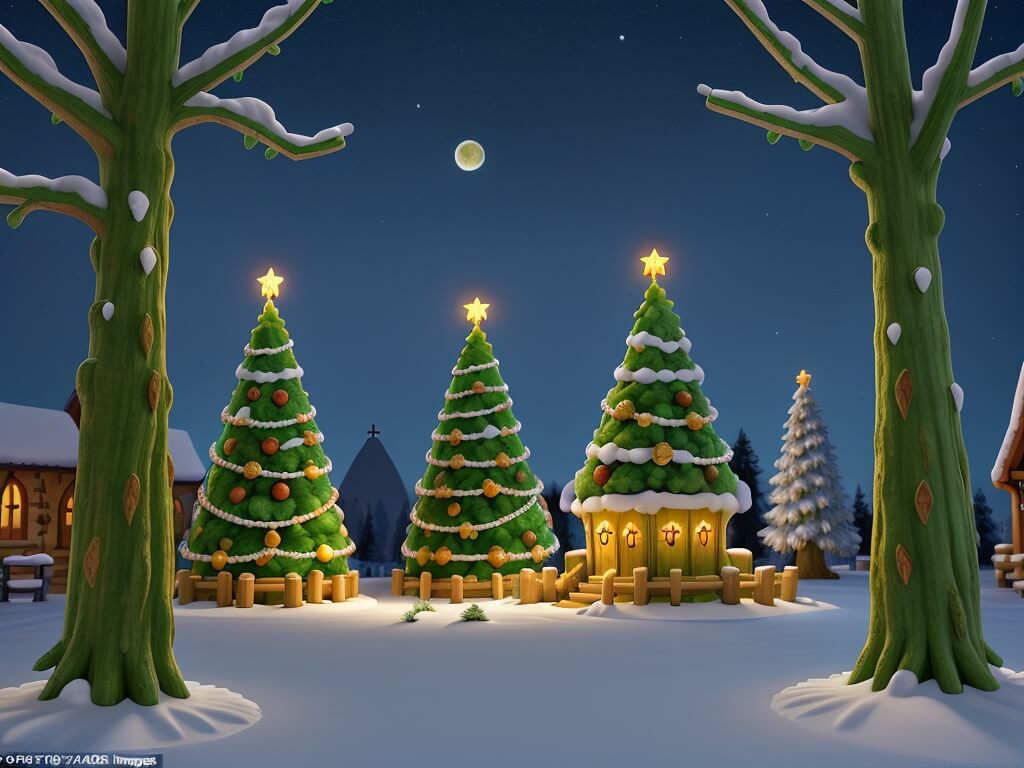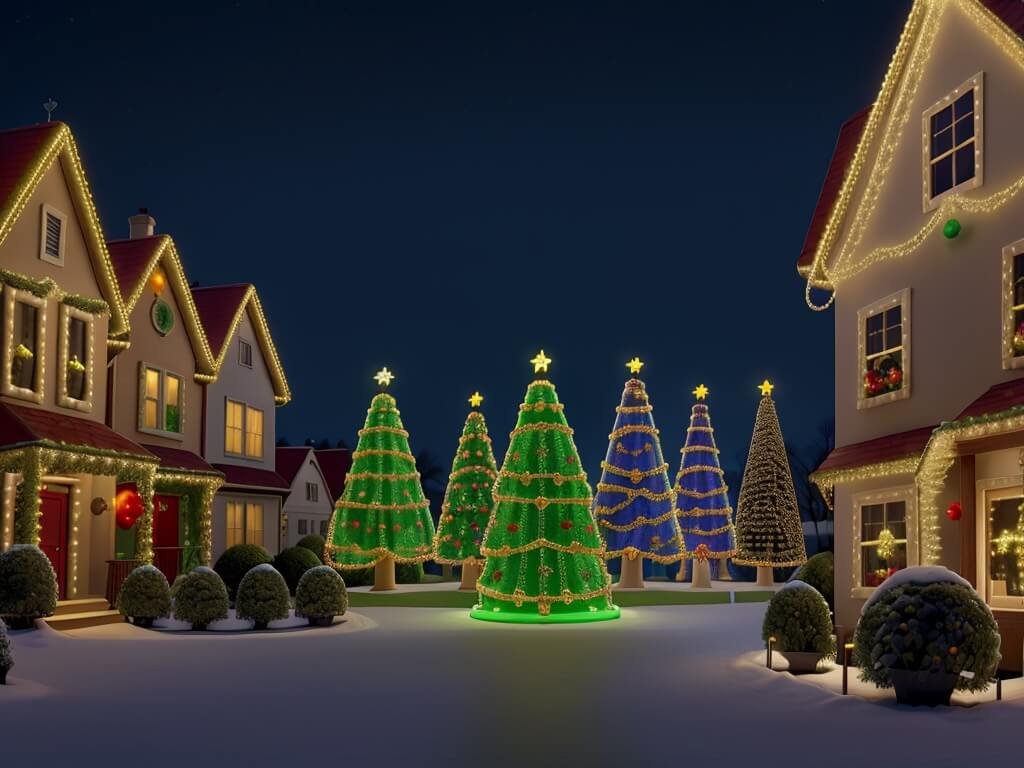Discover the rich history of the Christmas tree tradition, rooted in pagan, Roman, and Christian customs, dating back over a millennium. Uncover the transition from traditional candles to electric lights, with claims of Thomas Edison’s involvement and the emergence of commercially available electric light chains.

The historical roots of the Christmas tree tradition are intertwined with various cultural and religious practices, originating from pagan, Roman, and Christian traditions. While the exact origin of the Christmas tree remains somewhat ambiguous, it is generally believed to have emerged in Northern Europe around a thousand years ago.
Pagan customs involved the use of branches to decorate houses during the winter solstice, symbolizing the forthcoming arrival of spring. Romans, on the other hand, incorporated fir trees in their Saturnalia festival decorations, emphasizing their significance in festive celebrations. For Christians, the Christmas tree became a symbol of eternal life with God.
The earliest Christmas trees took on diverse forms. Some were suspended from ceilings with chains, while others were fashioned from cherry or hawthorn plants placed in pots and encouraged to bloom during the Christmas season. In cases where real plants were not available, people would construct pyramid-shaped trees adorned with paper, apples, and candles. These makeshift trees were sometimes transported from house to house for display.
The wooden pyramid trees, reminiscent of the Trees of Paradise, held particular significance. They featured in medieval German mystery and Miracle Plays, enacted outside churches on Christmas Eve. December 24 was historically associated with Adam and Eve in the church calendar, and the Tree of Paradise symbolized the Garden of Eden. Parades showcasing these trees preceded the plays, serving as a promotional tool for the performances, which conveyed biblical stories to those who could not read.
The documented history of Christmas trees in festive celebrations begins with a dispute between the cities of Tallinn in Estonia and Riga in Latvia. The Brotherhood of Blackheads, a local association of merchants, ship owners, and foreigners in Livonia, is credited with erecting the first Christmas trees. Tallinn claims the year 1441, and Riga asserts the year 1510 as the beginning of this tradition. These early trees were displayed in town squares, danced around by the Brotherhood of Blackheads, and subsequently set ablaze, akin to the Yule log custom.
The term “tree” in this context could encompass a mast or a stick, implying that these early trees may have taken the form of a wooden candelabrum rather than a genuine tree. In Riga’s city square, a plaque commemorates the “tree of the first new year in Riga in 1510,” underscoring the historical importance of these early Christmas trees.
In Germany, an image from 1521 depicts a tree parading through the streets with a man on horseback, potentially representing Saint Nicholas. By 1584, Riga had a tradition of a decorated fir tree in the market square, accompanied by singing, dancing, and eventual burning. Records from 1570 in Bremen, Germany, describe a small tree adorned with apples, nuts, dates, pretzels, and paper flowers displayed in a guild’s meeting place.
Martin Luther, the sixteenth-century German preacher, is associated with the transition to the modern concept of a Christmas tree. According to legend, Luther, one Christmas Eve, was struck by the beauty of stars shining through the forest’s branches, likening it to the nativity story. This tale is distinct from the earlier Riga tradition, suggesting that Christmas tree customs evolved independently in various regions.
The Christmas tree tradition may have traveled from Latvia to Germany, as these areas were part of neighboring empires in the 1400s and 1500s. Another legend ties the tradition to Saint Boniface, who is said to have converted pagan German tribes by cutting down an oak tree during a child sacrifice ritual, leading to the sprouting of a fir tree.
A heartwarming German legend tells of a poor boy who, on Christmas Eve, is welcomed into a ranger’s home and subsequently transforms into the Baby Jesus. In gratitude, the Child Jesus gifts the family a fir branch from the garden, initiating the tradition of bringing Christmas trees into homes.
Early German Christmas trees were adorned with edible decorations like gingerbread and apples covered in gold. Glassmakers later crafted ornaments, some of which are akin to those used today. The treetop decoration evolved from a figure of the Child Jesus to an angel or star symbolizing the Star of Bethlehem.

Christmas trees arrived in Britain in the 1830s and gained widespread popularity after Prince Albert, Queen Victoria’s German husband, introduced one at Windsor Castle in 1841. A drawing of “The Christmas Tree of the Queen at Windsor Castle” published in 1848 further popularized the tradition in the United Kingdom and the United States.
In Victorian times, candles were commonly used to decorate Christmas trees, symbolizing stars. Today, while electric lights have replaced candles, the Christmas tree tradition endures, uniting various cultural and religious influences in a global celebration of the holiday season.
Christmas tree lights
The invention and popularization of electric Christmas tree light chains mark a significant development in the history of Christmas decorations. Several claims surround the early adopters of these electric lights, shedding light on the transition from traditional candles to safer, electric alternatives.
One claim centers on Thomas Edison, the renowned inventor, who, in 1880, adorned his office with new electric bulbs. This early experiment laid the foundation for the use of electric lights for Christmas decorations. In 1882, Edward Johnson, a colleague of Edison, took a step further by assembling 80 red, white, and blue light bulbs and adorning his New York apartment’s Christmas tree. Notably, he also suspended two additional chains of 28 lights from the ceiling. These pioneering efforts showcased the potential of electric lights for festive displays.
The transition to commercially available electric Christmas lights gained momentum with the involvement of Edison’s company. In 1890, the Edison company published a brochure offering lighting services specifically for Christmas. By 1900, an advertisement by Edison featured light bulbs available for rent along with a lighting system for Christmas use. This, however, remained a luxury due to limited access to electricity in homes. The cost of installing electric lights for a single tree at the time was estimated to be around $300, equivalent to over $2,000 today.
While there are records of settlers in Montana using electric lights on Christmas trees in 1891, widespread use was hindered by the limited availability of electricity in households. The affluent few who could afford it showcased their extravagance by installing temporary electrical systems solely for Christmas celebrations.
The breakthrough in the popularization of electric Christmas tree lights came in 1895 when President Grover Cleveland illuminated the White House Christmas tree with electric lights to delight his daughters. This gesture marked the beginning of a cherished tradition, with the National Christmas Tree on the White House lawn commencing in 1923 during President Calvin Coolidge’s tenure.

The first commercially available electric light chains accessible to a broader population were introduced in 1903. These chains, consisting of 24 lights, were priced at $12, and they could also be rented for $1.50. While still relatively expensive, these chains offered a more affordable alternative compared to the earlier $300 installations.
An alternative claim for the invention of Christmas tree lights is attributed to Ralph Morris, an American telephone operator, who in 1908 used a telephone cable to attach small bulbs to a telephone exchange and decorated a table tree. His son, Leavitt Morris, later penned an article asserting his father’s role in Christmas tree light innovation, suggesting an independent origin from Edison’s lights.
The safety concerns associated with candles on Christmas trees were addressed in 1917 when a fire caused by candle-lit trees in New York prompted a teenager named Albert Sadacca to contemplate a safer alternative. Albert’s family was known for making wicker birdcages with embedded lights. His innovative idea involved using lights on long ropes and coloring the bulbs with vibrant shades like red and green. This led to the formation of the NOMA Electric Company, a renowned name in Christmas lights manufacturing.
The tradition of lighting Christmas trees with candles persisted in some places, despite mounting safety concerns. In 1908, insurance companies in the United States attempted to pass a law prohibiting the use of candles on Christmas trees due to the fire hazards they posed.
Additionally, artificial Christmas trees began to gain popularity in the early 20th century. During the Edwardian period, colored ostrich feathers were used to fashion Christmas trees for fashionable parties. The year 1900 saw a brief fashion for white trees, highlighting the enduring allure of unconventional Christmas tree decorations. These artificial trees were crafted from various materials, including feathers, papier-mâché, metal, glass, and various types of plastic.

The world’s tallest artificial Christmas tree, measuring 52 meters (170.6 feet) in height, was named the ‘Tree of Peace’ and featured green PVC leaves. It was exhibited in Porto Alegre, Brazil, from December 1, 2001, to January 6, 2002, showcasing the grandeur that artificial Christmas trees could achieve.
In various countries, diverse tree species are employed as Christmas trees. For instance, in New Zealand, the Pohutukawa tree with its red flowers is occasionally used, while in India, banana or mango trees are adorned for Christmas celebrations. These regional variations underscore the adaptability and universality of the Christmas tree tradition across the globe.